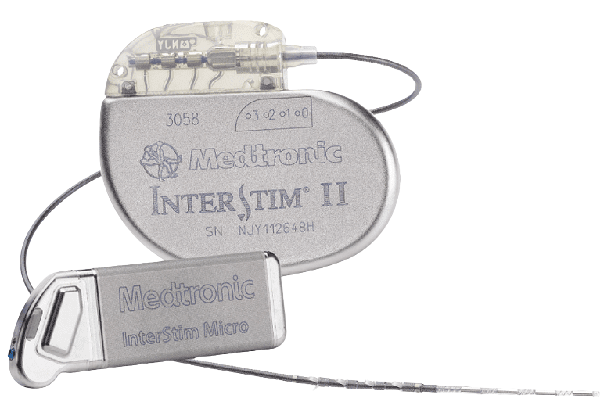What is sacral nerve stimulation?
Nerve stimulation is a reversible treatment for patients with bladder control problems in whom conservative treatments have not worked or have not been tolerated. Conservative treatments include behavioral therapies (diet modifications, biofeedback, bladder retraining, pelvic muscle exercises) and medications.
Sacral nerve stimulation involves electrical stimulation of the nerves that control the bladder. Nerve stimulation can address symptoms of overactive bladder including:
- Urinary Urgency – failure to be able to postpone the need to urinate
- Frequency of Urination – the need to urinate at least eight times per day
- Urge Incontinence – leakage of urine when one gets the urge to urinate
Sacral nerve stimulation also addresses the problem of nonobstructive urinary retention, a urinary condition defined by such markers as the need for a catheter to pass urine; spending considerable time in the bathroom, yet only able to produce a weak, dribbling stream of urine; urinary leakage; and not having a sensation that your bladder is full.


Additionally, sacral nerve stimulation is now FDA-approved for men and women with accidental bowel leakage, or fecal incontinence.
Sacral nerve stimulation will not alway cure these bladder and bowel control problems but it can reduce the number of voids and/or the number of wetting or incontinent episodes.
What are the benefits and risks of sacral nerve stimulation therapy?
The benefits of nerve stimulation therapy are that it can greatly reduce or eliminate bladder control problems, specifically urinary urge incontinence and urgency-frequency symptoms, in people who have symptoms of overactive bladder. It is also a type of treatment that can be completely reversed and discontinued at any time without permanent damage to the nerves.
Most risks or side effects are related to the device or the implantation procedure itself and are low and/or uncommon. The main risks include infection (about 3 to 4%), related to device implantation, or mechanical failure, in which case, the device would need to be reprogrammed or revised. Other problems such as pain at the implant site, lead movement, technical problems, and undesirable stimulations/sensations are not common and can be resolved, says the device manufacturer.
What can I expect in the typical pre and post-surgical period?
Typically, an in-office test is done called a peripheral nerve evaluation essayswriting.org. The diagnostic evaluation is a minimally invasive procedure with no incision. The average evaluation lasts from 15-30 minutes. Your physician will begin by numbing your skin with local anesthetic and then placing two small thin wires under the skin near the tail bone with a needle. The nerves that control bladder function are found below this area.
The two thin wires will be attached to an external device which will accompany you for approximately three to five days. The device will provide mild pulses of energy to the nerves that control the bladder as you return to your normal activities. Over the course of the test period, if you show an improvement in symptoms of 50% or greater, you may be a candidate for long-term treatment with Axonics or InterStim therapy.
(If the nerve evaluation does not show 50% improvement in your symptoms, a different test stimulation lead can be implanted — stage I. This simple outpatient operation of 30 to 45 minute duration is actually a 1- to 2-week trial of the device. It is undertaken to demonstrate the effects of sacral nerve stimulation on bladder control symptoms during everyday activities. If you have a 50% or greater improvement in symptoms, you can then proceed and have the long-term device implanted.)
The long-term implant is a minimally invasive procedure that is usually performed under local anesthesia on an outpatient basis. The surgical implantation typically takes no longer than 45 minutes to perform.
The incision area may feel sore and/or painful for a couple of weeks. This will lessen as you heal. You may return to your doctor’s office a few more times over a 6-month period to fine-tune your stimulation settings. Once adjusted to achieve the best control of your symptoms with the least discomfort, you may need to return to your physician’s office for check-ups only once or twice a year.
For the first 3 to 6 weeks after surgery, you will be advised to limit your activities to allow your incisions to fully heal. Once you are fully healed, you can resume your full and active lifestyle.
Will the device ever need to be replaced?
Yes. Older devices typically have a battery life of 4-6 years. Newer, rechargeable options can last for 15 years or more. The battery life will fluctuate per individual, depending on strength of the signal needed to control symptoms and amount of use each day. When it is time for the battery to be replaced, the entire neurostimulator will be replaced with a new one.
Are there any medical restrictions related to the device that I need to be made aware of?
Older models had metal in the lead which precluded MRIs. However, new technologies are now MRI-compatible. Diathermy (a type of energy treatment — using radio wave, ultrasound, or microwave) should not be done on any patient with a sacral nerve stimulator implant. Consult with your doctor before scheduling any additional therapies or tests. He or she will discuss the need to take any precautions.
Will insurance cover the cost of nerve stimulation therapy?
Many insurance companies will pay for the nerve stimulation therapy. Our office provides the currently approved devices Axonics Sacral Neuromodulation and Medtronic’s Interstim– have gone through clinical trials and has been found to be safe and effective and has been approved for use by the FDA.


